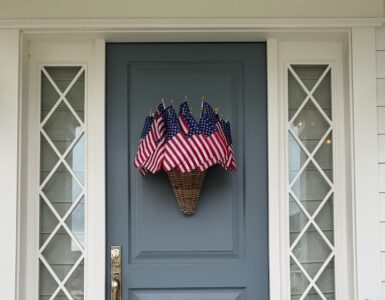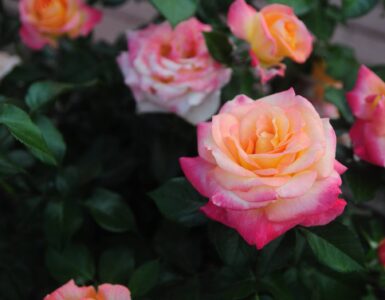Karen Timothy is the owner of Faux Techniques and is the expert to create a work of art in your home. With Karen’s help you can also do this yourself. Karen also has many amazing faux finishes that would turn an ordinary room into a beautiful place to live.
PREP
*Tape off all ceilings, trims, doors, and window frames with tape and 6″ paper. This will protect the areas you don’t want painted from getting paint and glaze on them. For about $20 you can get a taping tool from Home Depot that will put the tape on the paper for you. Saves a lot of time.
*Remove cover plates from light switches and plugs if desired.
*Cover floor with drop cloths.
PRIME
*If your wall is raw sheetrock or just has latex paint on it there is no need to prime at this point. Proceed to plaster step.
*If plastering over wallpaper, oil prime paper to the wall. DO NOT use latex primer. It will lift the wallpaper. If you take the wallpaper down, either scrub the paste off completely or oil prime the wall. If there is any paste on the wall, it will be activated by latex primer or paint and show through as a dark spot. If you have oil paint on the walls you need to oil prime them. Plaster is water-based and should not go over oil-based paint. You could sand the walls to de-gloss the oil paint but homes that were built prior to 1978 have a good chance of having lead in the oil paint and sanding the walls could lift the lead into the air.
Nutshell: If you have oil paint on your walls, oil prime them. Whether you take wallpaper down or leave it on, I recommend oil priming your walls.
PLASTER
*Use joint compound found in most hardware stores.
*For a smoother look, add water 1 cup at a time and stir into the top inch or two of plaster. When plaster becomes thick again and hard to stir, add more water. For a chunkier look, don’t add water…just stir the joint compound.
*Put joint compound onto a hawk. Using a 12″ trowel, bounce it on the joint compound to get plaster on the trowel. It resembles egg whites whipped into peaks and does not have to cover the entire trowel.
*Slide the trowel along the wall in a sweeping motion to unload the plaster. Then with the trowel at a slight angle, lightly sweep back across the plaster to “knock down” the ridges that are too sharp.
*Continue applying plaster in a random pattern all over the wall. You can either leave a lot of flat space between each spot of plaster or apply it fairly evenly all over.
*Dry overnight.
PAINT
1. Prime
*Prime the plaster using either oil or latex primer.
*It is perfectly OK to use latex products over oil PRIMER. The same is NOT true for paints. Never use latex paint over oil paint. It will not bond. Oil paint can go over latex or oil paint.
*If you’d like, tint your primer ½ the color of the paint you are going to use. It gives your wall a first coat of color.
*Dry 1 hour or according to the instructions on the can before painting.
2. Paint
*Paint the base color of your choice using either latex or oil paint.
*For best results paint two coats of base. Darker colors may require more.
*Use satin sheen paint. I prefer Kwal’s Ambassador paint in satin sheen. It has enough sheen to allow the glaze to move on the wall without being too shiny. Flat and even eggshell paints will grab the glaze and make it very hard, if not impossible, to
get an even look.
*I use a ¾” lambs wool roller to get the paint in all the nooks.
*Dry overnight.
GLAZE (For best results, 2 people should do this.)
*For a brown glaze, tint 1 gallon of Kwal’s Accu-Pro neutral base oil paint in eggshell sheen with 2 ounces of Raw Umber colorant. (Kwal can do this for you.) In a 2-gallon bucket, combine this with 1 quart of Penetrol and 2 ½ c. paint thinner. (For a dark charcoal glaze use 1 ½ ounces Raw Umber and 1 ½ ounces black colorant instead of the 2 ounces of Raw Umber.)
*Using a 3/16″ nap roller, roll a thin coat of glaze in an area approximately 2′ x 3′. Avoid straight lines – – – think puzzle pieces.
*Pull through the glaze with a 12-14″ squeegee wiping the squeegee off on a rag with each pull. This will leave glaze in all the contours of the plaster. Continue this over the entire wall connecting each piece to the next. While one person does this part the other person refines the look.
*After the glaze has been sitting in the cracks for about 5 or 6 minutes, dip your rags in the glaze and pat or rub back through it. This will take care of any glaze that has dripped and any marks left by the squeegee. Be careful not to pull all the glaze out of the cracks. If it does come out, wait a few more minutes for it to set up before ragging across it. You can also use a paintbrush on its side to blend any excess glaze.
*Allow to dry overnight before touching.
You can reach Karen Timothy at Faux Techniques, Home (801) 546-9460, Cell (801) 540-7786
Fauxtechniques.net















Add comment